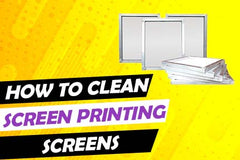Coating screens with emulsion is a simple and easy process. It involves filling a scoop coater trough with emulsion and coating each side of the screen mesh. Follow along as we start with the basics of coating screen mesh with emulsion.
1. The most popular tool for coating a screen with emulsion is a scoop coater. Scoop coaters are available in many sizes. An ideal size scoop coater for the beginning screen printer is 16" inches wide. This will cover the standard screen size of 20 inches wide by 24 inches long. You want at least one inch of clearance between the scoop coater edges and the inside edges of the screen frame. Check for flaws, nicks and damage to the coater edges. Damage and nicks to the edge of your scoop coater can damage the mesh of your screen. You want to make sure your scoop coater is clean before using it. Degreaser will work for great for this.
2. Fill the scoop coater only half full with emulsion. Over filling can become very messy and often lead to uneven coating once you begin coating the screen. It is also important to distribute the emulsion evenly across the inside of your scoop coater.
3. Using a screen holding stand, place the screen standing up and rest it against the wall. The print side or substrate side should be facing out. This is the first side of the screen to be coated. A screen holding rack will help you coat your screens easily and allow you to use both hands to hold your scoop coater. Grab your scoop coater with both hands, one on each end, and place the sharp edge of the scoop coater about an inch above the bottom of the inside screen frame. Roll the scoop coater forward until the emulsion touches the screen mesh all the way across the scoop coater and screen. This is called building a bead of emulsion on the mesh. Be careful not to roll the scoop coater to far forward. If you do the emulsion may spill out of the side of the scoop coater and cause a very uneven coating.
4. Slowly move the scoop coater up the screen mesh making sure to keep pressure so the scoop coater is touching the mesh along the way. By moving slowly up the mesh, the emulsion is consistent in thickness on the screen mesh. Coating screens has a distinctive zipping sound as the trough moves over the mesh. Once the scoop coater reaches an inch from the top edge of the inside frame slowly begin to rotate the scoop coater back and away from the mesh. This will allow the emulsion to flow back into the scoop coater and not drip on the screen. When the emulsion has made it back into the bottom of the scoop coater continue to move the scoop coater up the mesh so you can cleanly shear the remaining emulsion from the screen. Use the same process and steps just described to coat the inside (the ink side) of mesh. After coating both sides of the screen mesh in this manner you will have completed a one on one coat. A one on one coat is often enough for manual screen printing.
5. After your screens are coated with emulsion store them in a light safe darkroom. It must also be dust free. Store them print side down in the drying rack, this will allow the emulsion to pull down and through the mesh, fully encapsulating the mesh. A room with low humidity is best to dry screens fast.




Leave a comment